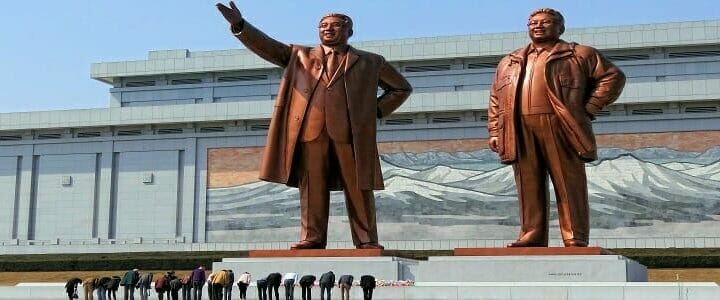I simply don’t know what to make of the situation in North Korea any more. The North continues to say the right things about denuclearization, while not actually doing anything to actually get us there. And yet, it’s not just President Donald Trump who is enamored with North Korean Chairman Kim Jong-un. South Korean President Moon Jae-in and a good portion of the South Korean population seem to be just as taken by the Democratic People’s Republic’s charm offensive.
It’s almost like Kim inherited Steve Jobs’ “reality distortion field,” the uncanny ability to employ charm and self-confidence to convince people to disbelieve what they saw with their own eyes. Moon was in the North this week for another “historic” summit that has produced sound and fury, pageantry, great photos, and grand pronouncements – but little real progress.
President Moon Appeals directly to the People of North Korea
Moon spoke at the “Mass Games,” a Korean spectacle where thousands of gymnasts and dancers perform synchronized routines for as many as 150,000 spectators. Think of the “cheer squad” from the February Winter Olympics, only more colorful and thousands of times larger, and you get the idea of the scale of the production.
Moon told the crowd, “We have lived together for 5,000 years and lived in separation for 70 years. I now propose that we completely eliminate the hostility of the past 70 years and take a big step forward in peace so that we can become one again.” Later, Moon told reporters that he and Kim are both eager to declare the Korean War over by this December. That would formally end what has technically only been in a ceasefire since 1953.
The current state of DPRK’s nuclear arsenal
Nearly everything that has happened – including Kim’s latest pledge to completely dismantle the Sochae rocket launching facility at Tongchang-ri, the two countries’ plan to submit a joint bid to host the 2032 Olympics, and Kim’s stated desire both to visit Seoul and to meet again with President Donald Trump – is encouraging, but superficial. Only the announcement of changes to military operations close to the border has any real impact on the prospects for peace.
We are still no closer to the complete, verifiable, and irreversible denuclearization of the Korean Peninsula than we were after the June Singapore summit. Dismantling the Sochae facility, where the DPRK launches satellites and tests rocket motors, is symbolic only, even if they allow inspectors to witness the process. The site plays a part in the DPRK’s missile program, but is otherwise unrelated to the development and production of nuclear warheads.
Will Kim give up his nukes – or is this just political theater?
The North’s 5MWe reactor at its main nuclear facility in Yongbyon has produced the plutonium fuel for the North’s entire nuclear arsenal. Throughout this entire process, workers have continued to upgrade and improve the reactor’s cooling system. Kim’s tantalizing offer of closing the Yongbyon facility has come only with the caveat that the U.S. must take “corresponding measures.” Just what might those be? Dismantling the Los Alamos or Oak Ridge facilities?
Meeting with Trump and Secretary of State Mike Pompeo are similarly symbolic acts. I was in favor of Trump meeting with Kim in June, despite concerns that doing so would be handing a dictator a propaganda victory without extracting anything tangible in return. Absent serious negotiations at lower levels where career diplomats hammer-out the real details of declaring and destroying the DPRK’s dozen-or-so nuclear warheads, another meeting with Trump would be a step too far.
Kim is talking a good game, and talking is better than shooting. But it’s time to start the real talking that will end the nuclear threat from North Korea. The U.S. and the Republic of Korea should of course be prepared to offer some concessions; that is how negotiations work. But remember: there is only one party maintaining a nuclear stockpile on the Korean Peninsula.




